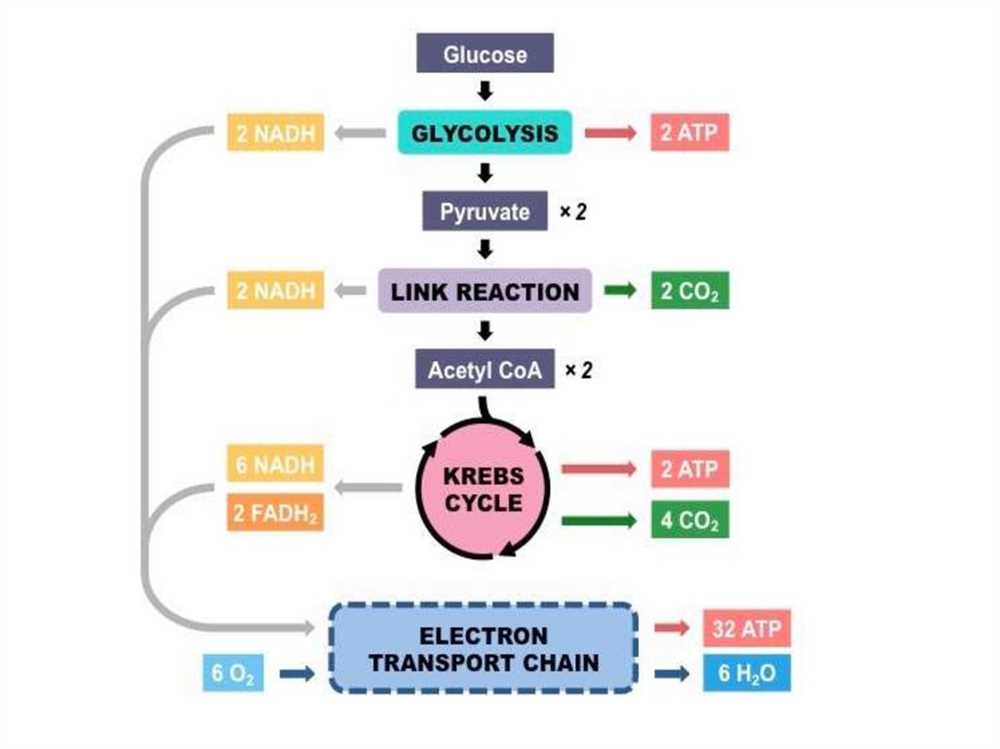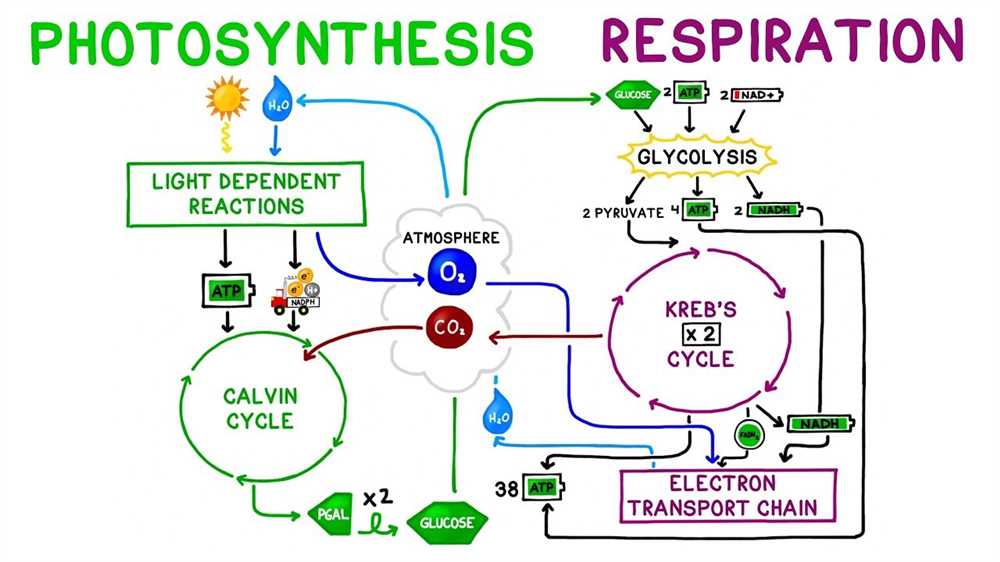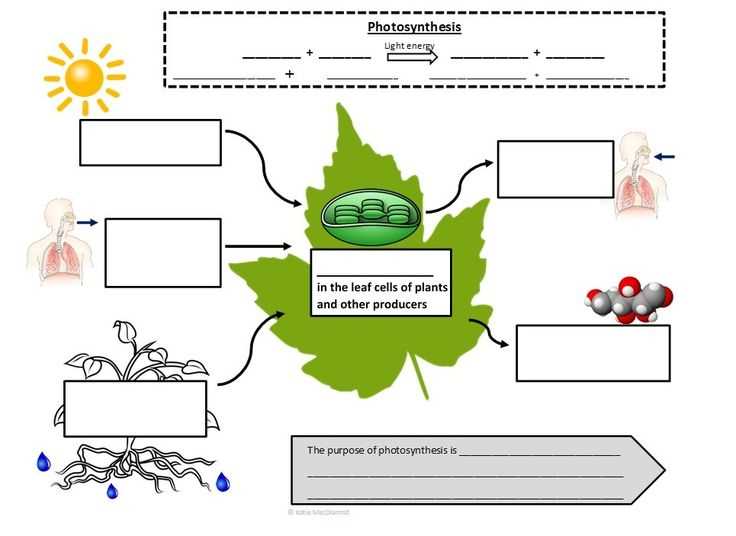
Cellular respiration is a complex process that occurs in the cells of living organisms, converting organic molecules into usable energy in the form of ATP. It is essential for the survival and growth of all living organisms, as it provides the energy needed for cellular activities.
During cellular respiration, organic molecules such as glucose are broken down in a series of enzymatic reactions, resulting in the production of ATP. This process takes place in three main stages: glycolysis, the Krebs cycle (also known as the citric acid cycle or tricarboxylic acid cycle), and oxidative phosphorylation.
Glycolysis is the first stage of cellular respiration and occurs in the cytoplasm of the cell. It involves the breakdown of glucose molecules into two pyruvate molecules, resulting in the production of a small amount of ATP and NADH.
The Krebs cycle takes place in the mitochondria and involves the complete oxidation of the pyruvate molecules produced during glycolysis. The Krebs cycle produces NADH and FADH2, which will be used in the next stage of cellular respiration.
Oxidative phosphorylation, the final stage of cellular respiration, takes place in the inner mitochondrial membrane. It involves the transfer of electrons from NADH and FADH2 to oxygen, generating a large amount of ATP through a process called chemiosmosis.
In summary, cellular respiration is a complex process that involves the breakdown of organic molecules and the production of ATP. Understanding the different stages and their inputs and outputs is crucial for understanding how cells obtain the energy they need to function properly.
Cellular Respiration Graphic Organizer Answers

Cellular respiration is the process by which cells convert glucose and oxygen into energy in the form of ATP. It occurs in the mitochondria of a cell and consists of three main stages: glycolysis, the Krebs cycle, and the electron transport chain.
Glycolysis: Glycolysis is the first stage of cellular respiration and takes place in the cytoplasm. It is an anaerobic process, meaning it does not require oxygen. During glycolysis, one molecule of glucose is broken down into two molecules of pyruvate. This process also produces a small amount of ATP and NADH.
Krebs cycle: The Krebs cycle, also known as the citric acid cycle, is the second stage of cellular respiration. It takes place in the mitochondria. During this cycle, the two molecules of pyruvate produced in glycolysis are further broken down, releasing carbon dioxide and producing ATP, NADH, and FADH2.
Electron transport chain: The electron transport chain is the final stage of cellular respiration. It occurs in the inner membrane of the mitochondria. During this stage, the NADH and FADH2 produced in glycolysis and the Krebs cycle donate electrons to a series of protein complexes. As the electrons move through these complexes, ATP is generated through a process called oxidative phosphorylation.
Overall, cellular respiration is a vital process for living organisms as it provides them with the energy they need to carry out essential functions. Without cellular respiration, organisms would not be able to generate ATP and would not survive.
What is Cellular Respiration?
Cellular respiration is a complex biochemical process that occurs in the cells of all living organisms. It is the key process by which cells convert the energy stored in glucose into usable energy in the form of ATP (adenosine triphosphate). ATP is often referred to as the “energy currency” of the cell, as it provides the fuel necessary for various cellular activities, including muscle contraction, nerve signaling, and protein synthesis.
The process of cellular respiration can be broken down into three main stages: glycolysis, the citric acid cycle (also known as the Krebs cycle), and oxidative phosphorylation. Each stage takes place in different cellular compartments and involves a series of chemical reactions that ultimately result in the production of ATP.
- Glycolysis: The first stage of cellular respiration, which occurs in the cytoplasm, starts with the breakdown of glucose into two molecules of pyruvate. This process generates a small amount of ATP and NADH (nicotinamide adenine dinucleotide).
- The Citric Acid Cycle: This stage takes place in the mitochondria and involves the further breakdown of pyruvate into carbon dioxide, releasing electrons that are captured by carrier molecules (NADH and FADH2). These electrons are then used in the next stage to generate more ATP.
- Oxidative Phosphorylation: This final stage occurs in the inner membrane of the mitochondria. Here, the electrons from NADH and FADH2 are passed through a series of protein complexes called the electron transport chain. This process generates a large amount of ATP through a process called chemiosmosis.
Overall, cellular respiration is a fundamental process that provides the energy necessary for a wide range of cellular functions. It is essential for the survival and function of all living organisms, from bacteria to plants to animals, and plays a central role in maintaining homeostasis in the body.
Why is Cellular Respiration Important?
Cellular respiration is a critical process for all living organisms, including plants, animals, and microorganisms. It plays a crucial role in the production of energy necessary for life by converting nutrients into a usable form of energy called adenosine triphosphate (ATP). This process occurs in the mitochondria of cells and involves several complex biochemical reactions.
Energy production: The primary purpose of cellular respiration is to generate ATP, which is often referred to as the “energy currency” of the cell. ATP provides the energy required for various cellular functions such as muscle contraction, nerve impulses, biosynthesis, and active transport across cell membranes. Without ATP, cells would lack the energy needed to perform essential tasks and would eventually die.
Breakdown of nutrients: Cellular respiration breaks down carbohydrates, fats, and proteins obtained from food into smaller molecules, such as glucose, fatty acids, and amino acids. These smaller molecules are then utilized in several biochemical reactions to produce ATP. This process not only provides energy but also helps in the recycling of molecules necessary for building new cells and performing various metabolic functions.
Waste removal: Along with energy production, cellular respiration is also responsible for the removal of waste products generated by metabolic processes within cells. During respiration, carbon dioxide, a waste product of energy production, is produced and removed from cells. This removal of waste gases helps maintain the balance of gases in the body and prevents the accumulation of toxic byproducts.
In summary, cellular respiration is vital for sustaining life as it provides the energy required for essential cellular functions, breaks down nutrients for energy production and recycling, and helps remove waste products. It is a fundamental process that ensures the survival and proper functioning of all living organisms.
Overview of Cellular Respiration Process

Cellular respiration is the process by which cells convert glucose and oxygen into energy in the form of ATP. This process occurs in three main stages: glycolysis, the citric acid cycle (also known as the Krebs cycle), and oxidative phosphorylation.
Glycolysis is the first step of cellular respiration and takes place in the cytoplasm. In this process, glucose is broken down into two molecules of pyruvate through a series of chemical reactions. Oxygen is not required for glycolysis, and it produces a small amount of ATP along with NADH, an electron carrier molecule.
The second stage of cellular respiration is the citric acid cycle, which takes place in the mitochondria. During this cycle, pyruvate is further oxidized to release carbon dioxide, and electrons are transferred to carrier molecules such as NADH and FADH2. These electron carriers will later be used in oxidative phosphorylation to generate more ATP.
The final stage, oxidative phosphorylation, occurs in the inner mitochondrial membrane. Here, the NADH and FADH2 molecules generated in the previous stages donate their electrons to an electron transport chain. This chain consists of a series of proteins that transfer electrons down the chain, creating a proton gradient across the membrane. As protons flow back through ATP synthase, ATP molecules are synthesized.
In summary, cellular respiration is a complex process that involves the breakdown of glucose and the generation of ATP through the stages of glycolysis, the citric acid cycle, and oxidative phosphorylation. This process is essential for cells to obtain energy for their metabolic activities.
Glycolysis: The First Step
Glycolysis is the first step in cellular respiration, and it occurs in the cytoplasm of the cell. It is the process by which glucose, a six-carbon molecule, is converted into two molecules of pyruvate, a three-carbon molecule. It is the first step in both aerobic and anaerobic respiration, and it does not require oxygen.
During glycolysis, glucose is broken down through a series of chemical reactions. The process begins with the phosphorylation of glucose, where one molecule of ATP is used to add a phosphate group to glucose, forming glucose-6-phosphate. This step requires an enzyme called hexokinase. Then, glucose-6-phosphate is converted into fructose-6-phosphate through a rearrangement reaction.
In the next step, fructose-6-phosphate is phosphorylated again, using another molecule of ATP. This forms fructose-1,6-bisphosphate. This step is catalyzed by the enzyme phosphofructokinase. Then, fructose-1,6-bisphosphate is split into two three-carbon fragments. Each fragment is converted into glyceraldehyde-3-phosphate through a series of reactions.
Glyceraldehyde-3-phosphate is then oxidized and phosphorylated, forming 1,3-bisphosphoglycerate. This reaction releases two molecules of NADH, a high-energy electron carrier molecule. Then, 1,3-bisphosphoglycerate is converted into 3-phosphoglycerate, followed by the transfer of a phosphate group to ADP to form ATP. This reaction is catalyzed by the enzyme phosphoglycerate kinase.
The final steps of glycolysis involve the conversion of 3-phosphoglycerate to pyruvate. The remaining phosphate group is transferred to ADP to produce ATP in two separate reactions, catalyzed by the enzymes phosphoglycerate mutase and enolase. Finally, pyruvate is formed, along with one molecule of ATP, for each molecule of glucose that entered glycolysis.
The Citric Acid Cycle: Generating Energy

The citric acid cycle, also known as the Krebs cycle or the tricarboxylic acid cycle (TCA cycle), is an essential metabolic pathway that takes place in the mitochondria of cells. It plays a crucial role in generating energy required by the cell. The cycle is a series of reactions that oxidize acetyl CoA, a molecule derived from carbohydrates, fats, and proteins, to produce energy-rich molecules.
The citric acid cycle is comprised of multiple steps and enzyme-catalyzed reactions. The cycle begins with the entry of acetyl CoA into the cycle, where it reacts with oxaloacetate to form citrate. Through a series of reactions, citrate is transformed into various intermediate molecules, releasing carbon dioxide and generating energy in the form of NADH and FADH2. These energy carriers are crucial for the subsequent energy-generating step, oxidative phosphorylation.
The citric acid cycle serves as a central hub for several metabolic pathways. It not only generates energy but also provides precursors for the synthesis of important molecules. Some intermediates of the cycle are used in the synthesis of amino acids, lipids, and other cellular components. This integration of energy generation and molecule synthesis makes the citric acid cycle a vital part of cellular metabolism.
Summary of the Citric Acid Cycle:
- Acetyl CoA combines with oxaloacetate to form citrate.
- Citrate undergoes a series of enzymatic reactions, resulting in the release of carbon dioxide and the generation of NADH and FADH2.
- The intermediate molecules of the cycle are used as precursors for the synthesis of various molecules.
- The cycle generates energy in the form of NADH and FADH2, which are utilized in oxidative phosphorylation to produce ATP.
In conclusion, the citric acid cycle is a crucial metabolic pathway that generates energy for the cell. It not only produces ATP but also provides precursors for the synthesis of important cellular components. Understanding the citric acid cycle is essential for comprehending cellular respiration and the overall functioning of living organisms.
Electron Transport Chain: Powerhouse of the Cell

The electron transport chain is a crucial part of cellular respiration, often referred to as the powerhouse of the cell. It is an intricate process that takes place in the inner mitochondrial membrane, where the majority of ATP synthesis occurs. The electron transport chain plays a central role in generating energy-rich molecules that are essential for sustaining cell function and carrying out various biological processes.
As the final stage of cellular respiration, the electron transport chain is responsible for capturing the energy released during the earlier steps and converting it into a usable form, ATP. It consists of a series of protein complexes and electron carriers that work together to facilitate the flow of electrons and protons across the mitochondrial membrane.
The electron transport chain begins with the transfer of electrons from NADH and FADH2, which are produced during the earlier stages of cellular respiration, to the first protein complex, known as complex I. From there, the electrons move through a series of protein complexes, including complex II and complex III, before reaching the final electron acceptor, oxygen.
As the electrons move through the protein complexes, they release energy that is used to pump protons across the inner mitochondrial membrane, creating an electrochemical gradient. This gradient creates a force that allows protons to flow back into the matrix through ATP synthase, a molecular machine that generates ATP. This process, known as oxidative phosphorylation, is responsible for the majority of ATP synthesis in cells.
In summary, the electron transport chain is a vital component of cellular respiration, acting as the powerhouse of the cell. It uses a series of protein complexes and electron carriers to transfer electrons and pump protons across the mitochondrial membrane, ultimately generating ATP through oxidative phosphorylation. Without the electron transport chain, cells would not be able to produce the energy necessary for their survival and various biological processes.